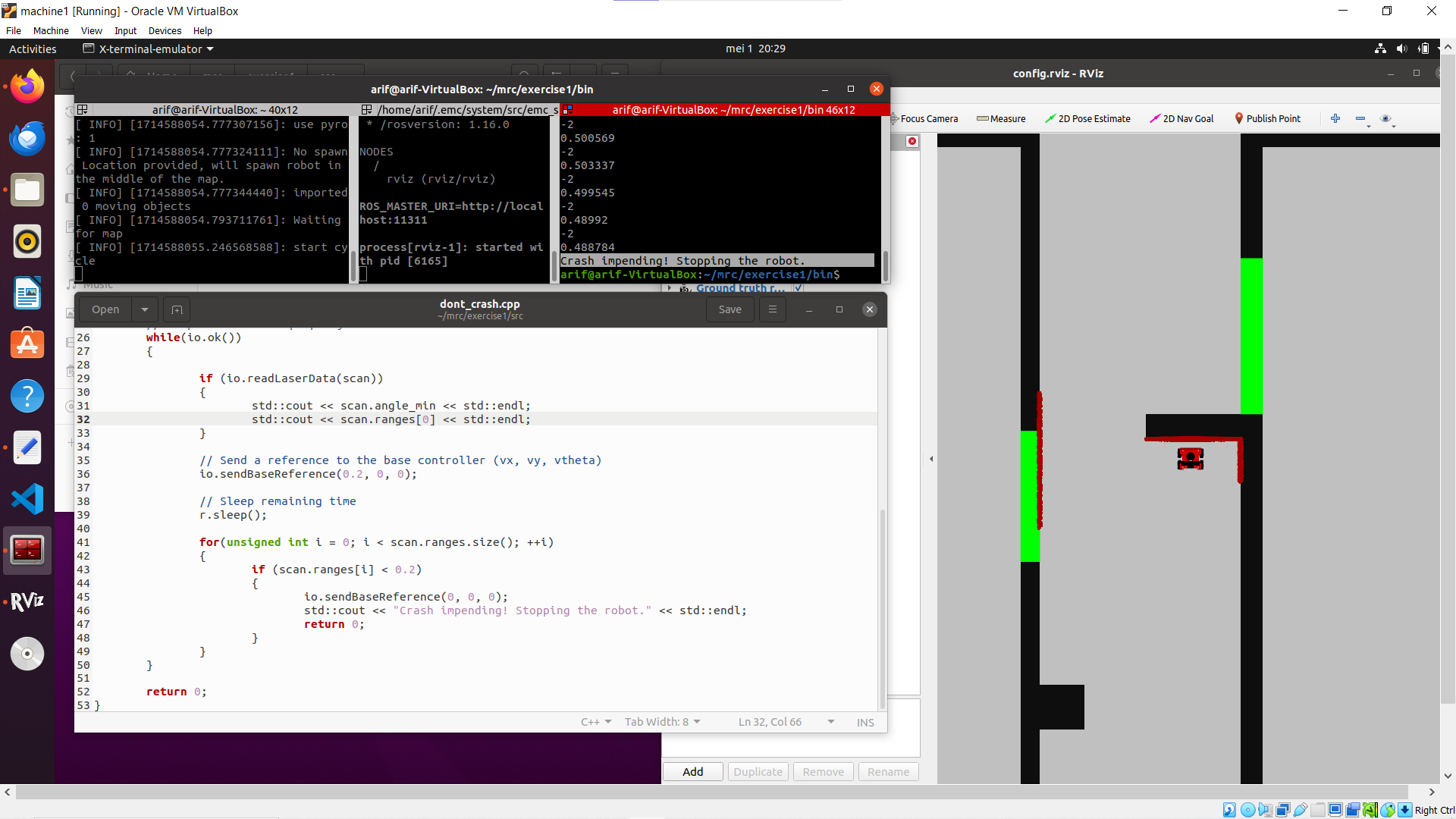Mobile Robot Control 2024 Robocop
Group members:
| Name | student ID |
|---|---|
| Matijs van Kempen | 2060256 |
| Luc Manders | 1729225 |
| Marc Quelle | 2044749 |
| Marijn Ruiter | 1489496 |
| Luke Alkemade | 1581643 |
| Arif Ashworth | 1544632 |
| Abhidnya Kadu | 1859234 |
Exercise 1
Method 1

In this method the LaserData struct is used to track the measured distances from the walls to the robot. To make the robot drive forward the sendBaseReference command is used, and the robot moves in the x direction at a speed of 0.2. Once it reaches the wall in front of it and the range values drop to below 0.2, motion is halted and a message is printed to the screen before exiting the program.
Some experimentation was done to test different speeds and thresholds for the stopping range values. When the speed was higher than the stopping range value the robot would actually crash into the wall first before stopping, and if it was lower then the robot would stop slightly farther away from the wall. However, this only seemed to be the case when the stopping value was very low (e.g. 0.1), but increasing it to 0.2, for example, allowed the speed to be increased to 0.4 without any crashing.
Exercise 2
Method 1


The previously described method was tested on the two provided maps with input speeds of (0.3, 0, +-0.3) and a stopping value of 0.2. With both maps the robot successfully came to a stop before crashing, although it struggled when driving into a corner and stopped much closer to the wall than it did in previous tests.
Practical Exercises 1
Dynamic Window Approach
The approach
The approach can be divided in the following sequential steps:
- Calculate the union between the Possible (angular) Velocities (Vs, Ws) and the Reachable (angular) Velocities (Vd, Wd)
- EXPLAIN HOW
- Iterate through the discretized values (v, w) of the union of Vs, Vd and Ws and Wd:
- Calculate the Admissable (angular) Velocities (Va,Wa) using v and w
- EXPLAIN HOW
- Check if v and w are also in Va and Wa, if this is the case:
- Calculate the optimization function value. If this value is higher than the previous optimization value, set the current v and w to v_final and w_final
- EXPLAIN HOW
- Calculate the optimization function value. If this value is higher than the previous optimization value, set the current v and w to v_final and w_final
- Calculate the Admissable (angular) Velocities (Va,Wa) using v and w
- Return v_final, w_final
Our approach for the Dynamic Window Approach (DWA) is that we first make a list of samples that fit inside the possible velocity limit (Vs) and reachable velocity and acceleration constraints (Vd). After which we
Questions
1. What are the advantages and disadvantages of your solutions?
Advantages:
- By constantly calculating possible trajectories it is able to avoid dynamic and static obstacles.
- By including the robot acceleration and deceleration constraints it ensures for a smooth navigation without abrupt movements.
Disadvantages:
- DWA may get trapped in a local minima.
- There is a high computational load in calculating the multiple trajectories in real-time
2. What are possible scenarios which can result in failures?
- Like mentioned in question 1 DWA can get trapped in a local minima.
- Solution: Include the global planner so it doesn't drive into a local minima
- We also encounter some problems when the robot is driving to a straight wall and can't decide with direction to take. (see video: https://gitlab.tue.nl/mobile-robot-control/mrc-2024/robocop/-/blob/main/videos_and_photos/dwa_straight_wall.mp4)
- Solution: Increase Ks and decrease Kh so the robot is less constrained to drive directly towards the goal.
3. How are the local and global planner linked together?
Vector Field Histograms
The approach (main idea)
Results
Questions
- What are the advantages and disadvantages of your solutions?
- What are possible scenarios which can result in failures?
- How would you prevent these scenarios from happening?
- How are the local and global planner linked together?
Questions
- How could finding the shortest path through the maze using the A* algorithm be made more efficient by placing the nodes differently? Sketch the small maze with the proposed nodes and the connections between them. Why would this be more efficient?
- Would implementing PRM in a map like the maze be efficient?
- What would change if the map suddenly changes (e.g. the map gets updated)?
- How did you connect the local and global planner?
- Test the combination of your local and global planner for a longer period of time on the real robot. What do you see that happens in terms of the calculated position of the robot? What is a way to solve this?
- Run the A* algorithm using the gridmap (with the provided nodelist) and using the PRM. What do you observe? Comment on the advantage of using PRM in an open space.
Upload screen recordings of the simulation results and comment on the behavior of the robot. If the robot does not make it to the end, describe what is going wrong and how you would solve it (if time would allow)
Upload video's of the robot's performance in real life (same as simulation videos), and comment the seen behavior (similar to the previous question).